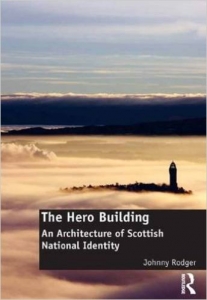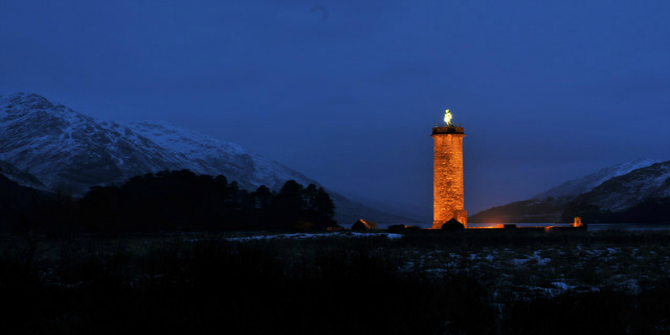In The Hero Building: An Architecture of Scottish National Identity, Johnny Rodger explores the role that commemorative monumental structures have played in Scotland as a mode of demonstrating national identity over the last two hundred years. This thought-provoking study will be invaluable for those looking to understand the idea of monumentality, both within and beyond a Scottish context, and will invite further examinations of the relationship between commemoration, identity and the urban, writes Kirsten Carter McKee.
The Hero Building: An Architecture of Scottish National Identity. Johnny Rodger. Routledge. 2015.
 This book explores the phenomenon of the secular commemorative monument – an artistic and architectural embellishment found in much of the built environment of the Western world, yet one whose wider resonance is often largely overlooked in the analysis of the urban realm. By examining the meanings behind the use of monumentality as a form of expression, Johnny Rodger considers the role that commemorative monumental structures have played in Scotland as a mode of demonstrating Scottish national identity over the last two hundred years. Using an approach that transcends traditional concepts surrounding the visibility, tangibility and the encapsulation of memory, The Hero Building: An Architecture of Scottish National Identity engages readers to consider a wider analysis of why monuments were, and continue to have, a key cultural presence in our society – and what the overall significance of this might ultimately be.
This book explores the phenomenon of the secular commemorative monument – an artistic and architectural embellishment found in much of the built environment of the Western world, yet one whose wider resonance is often largely overlooked in the analysis of the urban realm. By examining the meanings behind the use of monumentality as a form of expression, Johnny Rodger considers the role that commemorative monumental structures have played in Scotland as a mode of demonstrating Scottish national identity over the last two hundred years. Using an approach that transcends traditional concepts surrounding the visibility, tangibility and the encapsulation of memory, The Hero Building: An Architecture of Scottish National Identity engages readers to consider a wider analysis of why monuments were, and continue to have, a key cultural presence in our society – and what the overall significance of this might ultimately be.
Split into eleven chapters, The Hero Building begins by outlining the concept behind the book’s title, exploring our understanding of the commemorative monument both architecturally and conceptually, as well as in the form of a postmodern expression of cultural identity. Specifically, it discusses the ideas surrounding the Scottish commemorative monument, contextualising its place in Scottish society as a form of national identity through a cultural phraseology when no form of political identity existed. The subsequent ten chapters, which are split into thematic, chronological explorations of key types of memorials defined within their Scottish context, begin with an historiographical background and architectural introduction to the chosen structures, before going on to cross-examine each theme through the contemporaneous cultural context identified with each of the individual sites.
Rodger’s choice of sites covers the better known historical Scottish cultural icons – Robert Burns (Chapters Three and Seven), Sir Walter Scott (Chapter Five) and William Wallace (Chapter Six) – and adds to this mix some not so obvious examples found within slightly more remote corners of the Scottish landscape, such as the Glenfinnan Monument in Inverary and the McCaig monument in Oban (Chapters Two and Eight, respectively). As the author stipulates in the opening chapter, the examples included within The Hero Building do not provide an exhaustive list, but rather were chosen to allow further discussion of the broad depth of social processes involved in the erection of these types of monuments, as well as to demonstrate the variety of architectural and artistic rhetoric that characterises this subject matter.
 Image Credit: Glenfinnan Monument at Desk (Steven Brown CC 2.0)
Image Credit: Glenfinnan Monument at Desk (Steven Brown CC 2.0)
Rodger’s concept of the ‘Hero Building’, and his argument that this phenomenon is reflective of a wider Scottish social consciousness over the last two hundred years, makes for a perceptive approach that transcends any previous dialogue surrounding secular commemoration in Scotland during this period. Indeed, until this publication, very little work has attempted to contextualise the wider concept of commemoration and/or its purpose in the secular realm during the nineteenth and twentieth centuries. This book therefore attempts to emulate the detailed consideration of monumentality from a historical perspective, such as that found in Nigel Llewellyn’s work on the early modern era (The Art of Death: Visual Culture in the English Death Ritual, c. 1500 – c. 1800), alongside more architecturally focused approaches to specific memorial ‘types’, such as Alison Yarrington’s work on the British monuments of the Napoleonic era (The Commemoration of the Hero, 1800-1864). The author’s inclusion of both architectural and historical analysis for the chosen sites is given an added dimension by being discussed in tandem with scrutiny of selected excerpts from the contemporaneous written word. This provides an insightful consideration of the cultural context surrounding the creation of each building, and adds further depth to the overall analysis of each structure.
By choosing key examples throughout Scotland, the author’s narrative provides intriguing insight into deeper, more complicated stories surrounding the local politics of each site and their relationships with the wider consciousness of a national psyche. As excellent representations of styles, timeframes and concepts, the examples used in this book give a strong baseline for those interested in understanding the overall notion of the idea of monumentality, both within and outside of a Scottish context, and supports the need for a wider exploration of the relationship between commemoration, identity and the urban realm. The author’s creative and inclusive approach to his research therefore creates a nuanced discourse throughout the text, which expertly deconstructs the broader resonance of his examples, and strongly supports his overall argument of how a comprehensive analysis of monumental structures and their establishment within urban landscapes can help us to better understand the societies that created these sites.
This work fills a long-awaited gap in the discourse surrounding the role of the commemorative monument in Scotland during the modern era. Although recognised as a multicultural urban phenomenon throughout the Western world, an exploration of the purpose of monumentality outside of the ecclesiastical and political climate is one that has not previously been readily attempted. Indeed, it is only in the context of the re-establishment of a Scottish political voice through the re-founding of a Scottish Parliament at the end of the twentieth century that it has become possible to begin recognising the impact that cultural perpetuity, led by civic society, has had in preserving a Scottish sense of self where no official national sense existed.
More widely, the role of the commemorative monument within the built environment is approached in a manner that is wholly influential to the study of modern monumentality throughout a Western context. This book therefore broadens the scope of the academic discourse surrounding this genre, leading the way for a much more cross-disciplinary approach to the analysis of the commemorative monument and its significance within the urban realm. The Hero Building would therefore be a useful book for further considerations of the concept of why we humans feel the need to erect memorials, as Rodger’s work skillfully explores some of the big questions surrounding this phenomenon through his thought-provoking study.
Dr Kirsten Carter McKee is a teaching fellow and researcher in Architectural History and Conservation at the University of Edinburgh. Her work focuses primarily on Cultural Landscapes, and she works with various charitable and government organisations to assist in community land buyout and heritage-focused projects. Her website can be found here (www.urbanmemory.co.uk).
Note: This review gives the views of the author, and not the position of the LSE Review of Books blog, or of the London School of Economics.






